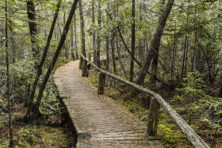What’s Living at The Ridges?
- Share
- Tweet
- Pin
- Share

Sanctuary plans first major plant survey since 1983
The Ridges Sanctuary has some of the most diversified habitat in the Midwest in a relatively compact area, and the sanctuary’s leaders want an update on what’s living there.
Forty years have passed since the last meticulous plant survey was completed at the Baileys Harbor–based nature preserve, and research director and biologist Tony Kiszonas said the time is right to get to work again on the multiyear effort to document all of the plant species.

Though The Ridges was founded in 1937 for the preservation of the historical range lights, its promoters also recognized that the land – a far-south swath of boreal forest with ancient dunes and swales and wetlands – harbored an amazing array of orchids. Partly for that reason, UW-Green Bay students, overseen by Joel Tricke, performed an extensive, multi-month survey of the plant life at The Ridges in 1982 and 1983.
“The Ridges itself is a really special spot, with many microhabitats. We don’t really know what we’re going to find,” said Ridges volunteer Jane Whitney. “Over the past 20 years, we’ve come up with 29 species of orchids, and that was a very focused survey. This is a much larger, comprehensive survey, so we anticipate finding some plants of special concern, right on the cusp, perhaps, of being threatened.”
Current UW-Green Bay professor and herbarium curator Keir Wefferling is helping and providing training this time around. Some staff members have plant-survey experience, including The Ridges’ land manager, Sam Hoffman. Whitney, David Barnes and Julie Knox all have experience leading orchid treks, locating the orchids that pop up year-round at various locations on The Ridges’ 1,600 acres.
Barnes, said Kiszonas, is “uncanny at spotting orchids,” and Whitney and Knox helped with inventory work around the Logan Creek site near Clark Lake and the Hidden Brook parcel prior to boardwalk installation. Whitney, Knox and Barnes made some of the latest orchid discoveries: shining ladies’-tresses and Case’s ladies’-tresses, which are small plants with white flowers that spiral around the stem.
Whitney said it’s important to set up a survey protocol and document the plant life throughout the sanctuary once again.
“One of the missions of The Ridges is to protect and preserve,” she said, “and it’s really hard to protect and preserve if you don’t know what you’re protecting and preserving.”
They also don’t know where those discoveries might occur, given that orchids grow in different conditions at different locations. Kiszonas does not publicly provide locations of orchids, but one of the most recent discoveries of a rare orchid happened after it sprouted in the middle of a dirt path. Whitney said different plants bloom and become apparent at different times of year.
“We still have orchids blooming across from the Lower Range Light,” she said Oct. 2. “Little white orchids, nodding ladies’-tresses. Wisconsin has between 45 and 50 native species of orchids, and orchids like it cold. They like sphagnum moss. The Ridges botanically is defined as boreal forest, way outside of its normal range, and cold-loving species are really happy in some of those microhabitats.”

This fall, the staff and volunteers went out to one small, three-acre site near the Nature Center that was not as difficult to explore as some brushy, mucky areas. They looked for and documented all plants, whether showy or lowly – late-blooming orchids in the former camp, and mosses and spore-producing plants in the latter. They’re also studying techniques and strategizing about which portions of the property to visit and when to trek into them at various times throughout the year.
“We completed our first small parcel of land a couple of weeks ago,” Kiszonas said. “We’re trying to establish the how-to.”
Part of that, Whitney said, will require monthly field visits, revisiting many spots at various times. But that inventory methodology is still being developed so that future generations can replicate it.
Kiszonas said the process would be daunting if The Ridges didn’t have a core group of volunteers who are great at identifying plants and a large group that’s eager to learn.
“The group of volunteers we have up here are ready to go, ready to take on something like this,” he said. “The time is right.”
Want to Help?
Contact Tony Kiszonas, The Ridges Sanctuary’s research director, at 920.839.2802, or stop by to inquire at The Ridges’ Nature Center, 8166 Hwy 57 in Baileys Harbor.


